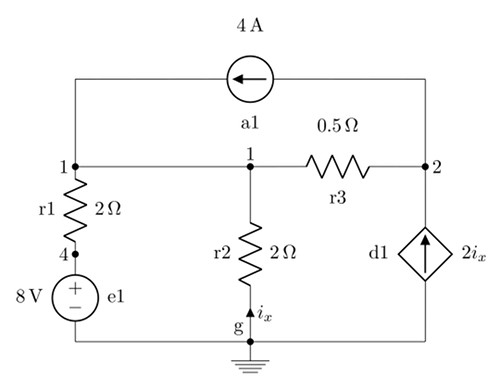Nodal.py is a simple electrical circuit simulator that uses nodal analysis to solve linear networks made up of resistors and ideal current or voltage sources, both independent and controlled.
The intendend use case of nodal is through the two provided commandline scripts. Even so, the package has been carefully written so that it might be used to programmatically simulate circuits from inside another application.
The numerical work is done by the numpy package. For larger circuits, the user may choose to use sparce matrices, in which case computation is powered by scipy instead.
To get the stable release download it and run
$ pip install nodal-1.3.0.whl
To try out the latest developments use flit instead:
$ git clone https://github.com/EnricoMiccoli/nodal.git
$ cd nodal
$ flit install
All scripts read their input from a netlist in the csv format. Each line represents a component and contains informations about its electrical values (e.g. the resistance in ohm for a resistor) and all the connections it makes with other components.
Many annotated examples of netlists are available in the doc/ directory.
Usage: $ nodal-solver netlist.csv. If the circuit is particularly large, one might use $ nodal-solver -s netlist.csv instead to save memory and runtime.
The output is printed in the following format:
e(node_name) = node potential (volt)
i(component_name) = current passing through the component (ampere)
The ground node is used as a potential reference. It is set at 0 volt.
Usage: $ nodal-resistance netlist.csv or $ nodal-resistance -s netlist.csv.
This will print the equivalent resistance (unit is ohm) as seen through the nodes named 1 and g in the netlist.
| Type | Value | Lead + | Lead - | Control + | Control - | Driver | |
|---|---|---|---|---|---|---|---|
| Resistor | R | resistance (ohm) | first | second | NA | NA | NA |
| Voltage source | E | voltage (volt) | + voltage | ground | NA | NA | NA |
| Current source | A | current (ampere) | + current | ground | NA | NA | NA |
| CCCS | CCCS | gain (adimensional) | + current | ground | + driving current | - driving current | component determining the current |
| CCVS | CCVS | gain (ohm) | + tension | ground | + driving current | - driving current | component determining the current |
| VCCS | VCCS | gain (ohm^-1) | + current | ground | + driving voltage | - driving voltage | NA |
| VCVS | VCVS | gain (adimensional) | + voltage | ground | + driving voltage | - driving voltage | NA |
| OPAMP, simulated | OPMODEL | feedback resistance (ohm) | output | ground | + terminal | - terminal | NA |
Note that opamps are not supported directly, but they are instead internally simulated with an equivalent circuit. For example this is the circuit generated to model a voltage buffer:
Suppose we wanted to solve this circuit:
First we would prepare a file describing the circuit. Each line represents a component, using the format
name, type, value, first lead, second lead.
Input file netlist.csv:
a1,A,1,1,3
r1,R,1,1,2
r2,R,1,2,3
Take notice of the orientation of the current generator: current flows toward the node connected to the first lead. Component type can either be
Afor current generatorsRfor resistors
Default units are ampere and ohm.
We can then execute $ nodal-solver netlist.csv to get the list of node potentials (unit is volt).
Printed output:
Ground node: 1
e(2) = -1.0
e(3) = -2.0
Example circuit from: Esercizi da temi d'esame di Elettrotecnica
Input file 1.6.1.csv:
r1,R,2,1,4
r2,R,2,1,g
r3,R,0.5,1,2
e1,E,8,4,g
a1,A,4,1,2
d1,CCCS,2,2,g,1,g,r2
Output:
Ground node: g
e(1) = 2.0
e(2) = -1.0
e(4) = 8.0
i(d1) = -2.0
i(e1) = 3.0


